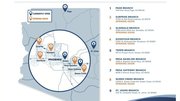News
Euro conversion largely free of ATM-related problems
Much like Y2K in 2000, ATMs performed well during the changeover of 12 European countries to the euro earlier this month.
January 14, 2002
The New Year was ushered in with the usual parties and champagne in Europe, but this year the humble ATM figured into the celebration, playing a big part in a real new beginning for 12 European countries.
On the historic occasion when 300 million people from Ireland, Finland, the Netherlands, Belgium, Portugal, Spain, France, Italy, Austria, Greece, Luxembourg and Germany said goodbye to their national currencies and embraced the euro, many of them got their first exposure to the new currency at an ATM.
In the run-up to Christmas, more than 200 million "starter packs" containing coins were sold, but the first point of delivery for the notes was the ATM. Perhaps this explains the enthusiasm.
"On all the news programs the next day, all you saw was people queuing up to get euro," said Guillaume Lepecq of Agis Consulting, who worked with De La Rue for the launch.
The early bird
The European Commission was well aware of how important use of the ATM was for a successful transition to the new currency. As Benjamin Angel, who was responsible for transition issues for the European Commission, pointed out in an online forum held by De La Rue in November 2001, the ATM would allow the euro to be introduced quickly, hopefully cutting down the period of dual circulation.
At ATM manufacturer NCR, teams began working on the changeover in 1996, when its customers first started asking what needed to be done to prepare for the change.
There are approximately 250,000 ATMs in the eurozone according to the European Central Bank (ECB), of which NCR claim to have provided 50 percent of the market. This presented quite a challenge as some countries like Austria and Belgium planned to convert overnight while others like France aimed for a one-week time scale.
'The biggest problem," said Ian Buxton, senior consultant on the euro for NCR, "was the changeover was on a national holiday, followed by another national holiday."
According to Buxton, most of NCR's customers chose the option of running two cassettes loaded with euro and two with national currency. Most of them typically use three or four cassettes, so it was relatively easy to load the machines with both currencies.
This way the machine would dole out marks or pesetas until 11:59 p.m. Dec. 31; then on the stroke of midnight, the software would automatically switch to the euro.
In terms of converting machines, it proved relatively simple in the end. NCR was allowed access to the notes in the year 2000, which gave them enough time to ascertain what changes were needed and complete them.
"The only real practical change was to resize the cassettes," Buxton said. "We've done it before, but obviously not on the same scale."
De La Rue, which due to demand ended up printing notes for the ECB and provided updates to its software for cash handling, was also involved in cassette re-sizing for its customers.
"We produced 160,000 cassettes to accommodate the new euro note size," said Steve Williams, euro production manager at De La Rue. "Our production plants were running at up to three times the usual capacity."
All about logistics
As Angel of the EC stated, it was basically a logistical challenge. It came down to getting the money out to the banks and re-filling ATMs swiftly enough to cope with demand. For the security companies responsible for physically transporting the money all around Europe, it was a hectic time.
"They didn't want to buy new lorries and employ extra staff for a two-month window," said Buxton.
However, some firms like the UK security company Securicor, which has eurozone operations in Germany, Ireland and Luxembourg, did double the amount of vehicles out on the roads. Nick Buckles, the chief executive designate of Securicor, told the Financial Timesat the end of the December that the 24 hours over the New Year would be its biggest-ever stretch of resources.
In recognition of the problem of ensuring all banks had as many euro as needed, the ECB made the decision to frontload the notes. Banks began to get the first samples of the euro from Sept. 1 2001, with around €134 billion distributed prior to the launch.
A night to remember
Many companies made extra staff available on the night and in the run-up to the changeover. De La Rue flew in some engineers from America for a week and had staff on 24-hour standby. Its advice centers fielded lots of extra calls from Dec. 31 to Jan. 2. "In one country there were six times the normal number of calls," said Williams, "although this backlog has now fallen."
From country to country, midnight brought queues and record numbers of withdrawals. Not everything went smoothly with, according to various reports, some machines giving out euros a little earlier than planned and others stubbornly sticking to the old currency.
Some machines went on strike completely, as various journalists recorded their attempts to draw out money had failed. According to the Wall Street Journal Europe, one machine in Paris had the cheek to give out francs while proclaiming: "Starting Jan. 1, 2002, this machine dispenses euros."
In a statement on Jan. 2, the ECB said that some countries had seen up to four times the normal amount of cash withdrawn. The enthusiasm for the euro varied from country to country. In France €613 million was withdrawn between Jan. 1-5, whereas in Italy €1006 million was withdrawn between Jan. 1-3. Some ATMs, such as those in Spain, saw as many as 250 million transactions from Jan. 1-3, while there were nine million in Italy in the same time period.
In the half hour after midnight, Deutsche Bank's 1,700 machines saw more than 10,000 cash withdrawals. The amount being drawn out led the German government to ask people to show restraint, as it feared the ATMs would run out of money.
Belgian banks recorded 600 withdrawals a minute in the first two hours of the New Year. The Netherlands saw more than 300,000 ATM transactions in the first six hours of 2002, according to Interpay, which is responsible for interbank transactions there. Even with only 47 per cent of its ATMs stocked with euro, Portugal still managed 106,000 withdrawals by early on Jan. 2.
The demand has been so high, that the ECB has admitted there has been shortage of smaller denominations, mainly coins, at a local level.
There were a few additional problems for consumers to worry about, such as the financial services group ING in the Netherlands overcharging up to 10,000 people for withdrawals on Jan. 1-2. They denied it was anything to do with the euro, instead blaming a system failure.
In Austria 2,600 machines were out of action for an hour on Jan. 2, but the company that runs them, Europay Austria, claimed it was due to a failure of the central computer memory system.
On the whole the ATM conversion was quicker than expected, with, according to a statement released by the ECB on Jan. 3, Belgium, Germany, Greece, Ireland, Luxembourg, the Netherlands and Austria all achieving 100 percent within the first few days. Italy was the slowest, with only 85 percent at this time.
As of Jan. 7, the ECB announced that all of the eurozone's ATMs had been converted.
The aftermath
"The amazing thing was it went relatively well on the night," said Buxton of NCR. "From our point of view it was like a Monday, with all the problems stemming from typical Monday issues, like a cassette put in the wrong way."
Williams, of De La Rue, said most of its customers' problems stemmed from over loading the cassettes with euro. Another problem was that some staff had failed to fan out bundles of the euro to break them apart, as instructed, which meant some machines had problems distributing them.
Although everyone was waiting for a disaster, it is interesting that Buxton says: "We learned a lot from the year 2000." The Y2K-related predictions of doom for that New Year also proved to be unfounded.
Lepecq believes it went well because the overwhelming demand for the euro meant people purchased coins early and got hold of the euro very quickly on Jan. 1. "The number of transactions was a lot higher than predicted, because the ATMs were ready and re-filled a lot quicker than was hoped possible."
Jean-Francois Taillandier, manager of the self-service network for French bank BRED Banque Poulaire, said that while 60 of his bank's ATMs were out of order at 8 a.m. on Jan. 1, that number had dwindled to only a dozen by 7 p.m. "At the end of (Jan. 1), we had 78 percent up and running," he said.
The bank prepared by loading half its cassettes in francs and half in euros, mainly 5, 10, 20 and 100 euro notes. The major problem, he said, was jams caused by the stickiness of new notes. "We had a similar problem six years ago when we changed the old 100 franc notes. It is always the same."
In some busy locations, the ATMs have dispensed as much as 50,000 euro a day, Taillandier said. "For security reasons, we cannot put more than 150 kilo euro in the machine," he said, noting that amounts to three cassettes of 20 euro notes, the most popular denomination. "Our 250 branches are filling them up daily."
We're still at a high level of distribution at the moment," he said last week, "although we are giving out less than the Saturday before Christmas, which is traditionally one of our busiest times."














